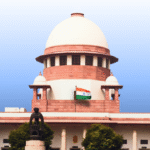SARFAESI Act, 2002 – Sections 13, 14, 17, 17(4-A), 35; Transfer of Property Act, 1882 – Sections 65A, 107, 111; Kerala Buildings (Lease and Rent Control) Act, 1965 – Section 11; Constitution of India – Article 226.
Debt Recovery – SARFAESI Proceedings – Tenancy Rights – Conflict of Laws – Suppression of Material Facts – Writ Jurisdiction.
(2025) 7 KCD 302 : 2025 KER 56062
IN THE HIGH COURT OF KERALA
CORAM: HONOURABLE MR. JUSTICE ANIL K.NARENDRAN HONOURABLE MR. JUSTICE MURALEE KRISHNA S.
W.A. NO. 1577 OF 2025; 30TH JULY 2025
Background of the Dispute: The appellant (tenant) occupied a portion of a building for a Scanning and Diagnostic Centre based on a registered rent agreement (Ext.P1) dated 29.04.2023, for a period of seven years. The building was mortgaged to the 1st respondent Bank by the 2nd respondent (landlord and guarantor) on 02.04.2014, long before the lease agreement. The loan secured by the mortgage was classified as a Non-Performing Asset (NPA), and the Bank initiated securitisation measures under the SARFAESI Act, including issuing a Section 13(2) notice on 23.06.2023. The appellant challenged these measures before the Debts Recovery Tribunal (DRT) and the Debts Recovery Appellate Tribunal (DRAT), both of which dismissed her applications. She then filed a writ petition under Article 226 of the Constitution of India, which was dismissed by a learned Single Judge, leading to this writ appeal.
Appellant’s Contentions: The appellant argued that as a valid tenant, she could not be dispossessed under Section 14 of the SARFAESI Act and that the Kerala Buildings (Lease and Rent Control) Act, 1965, has primacy, requiring eviction only under Section 11 of that Act. She relied on the judgment in Shiju Mani v. CSB.
Bank’s Contentions: The Bank contended that the tenancy was created after the mortgage and was in violation of Section 65A of the Transfer of Property Act, 1882, and the terms of the mortgage deed, which prohibited the creation of encumbrances without the Bank’s consent. It also argued that the appellant suppressed the filing and dismissal of a previous Original Petition (DRT) (OP(DRT) No.398 of 2024) before the High Court.
Legal Issues Considered:
Applicability of Rent Control Act: Whether a tenant inducted into a secured asset after the mortgage and NPA classification, but before the Section 13(2) notice, can claim protection under the Rent Control Act against eviction.
Validity of Lease under T.P. Act: Whether the lease agreement complied with the provisions of Section 65A of the Transfer of Property Act, particularly Section 65A(2)(e), which limits the duration of leases of mortgaged buildings to three years and requires a re-entry covenant.
SARFAESI Act’s Overriding Effect: The interplay between the SARFAESI Act, the T.P. Act, and the Rent Control Act, especially in light of Section 35 of the SARFAESI Act, which gives it an overriding effect.
Jurisdiction of DRT under Section 17(4-A) SARFAESI Act: The scope of the Debts Recovery Tribunal’s power to examine tenancy claims, including those contrary to Section 65A T.P. Act or the terms of the mortgage.
Impact of Suppression of Facts: The effect of the appellant’s failure to disclose material facts, such as the previous O.P.(DRT) filing, on her entitlement to discretionary relief under Article 226.
Court’s Findings and Decision:
The Court found that the lease agreement (Ext.P1) dated 29.04.2023 for a seven-year period violated Section 65A(2)(e) of the T.P. Act, which mandates that leases of mortgaged buildings shall not exceed three years and must include a re-entry covenant.
The lease also violated the terms of the mortgage deed, which explicitly restrained the mortgagor (2nd respondent) from creating any further charge or encumbrance over the property without the Bank’s prior written permission.
The Court held that protection under the Rent Control Act is available only to a tenant who was lawfully inducted into the secured asset and not to a tenant who occupies it in violation of provisions of law.
The Court disagreed with the reasoning in Shiju Mani v. CSB to the extent that it suggested the Debts Recovery Tribunal should relegate parties to the Rent Control Court for eviction even if the lease is found unlawful or terminated. The Court affirmed that Section 17(4-A) of the SARFAESI Act grants the Debts Recovery Tribunal the jurisdiction to determine whether a lease is lawful, has expired, or stood determined.
The Court emphasized that Section 35 of the SARFAESI Act gives it an overriding effect on other inconsistent laws.
The Court also noted that the appellant suppressed the filing and dismissal of OP(DRT) No.398 of 2024, which disentitled her from obtaining discretionary relief under Article 226 of the Constitution of India, as a litigant must approach the court with clean hands and disclose all material facts.
Result: The writ appeal was dismissed, upholding the Single Judge’s judgment. The appellant was found not entitled to claim protection under the Rent Control Act or the reliefs sought under Article 226.


